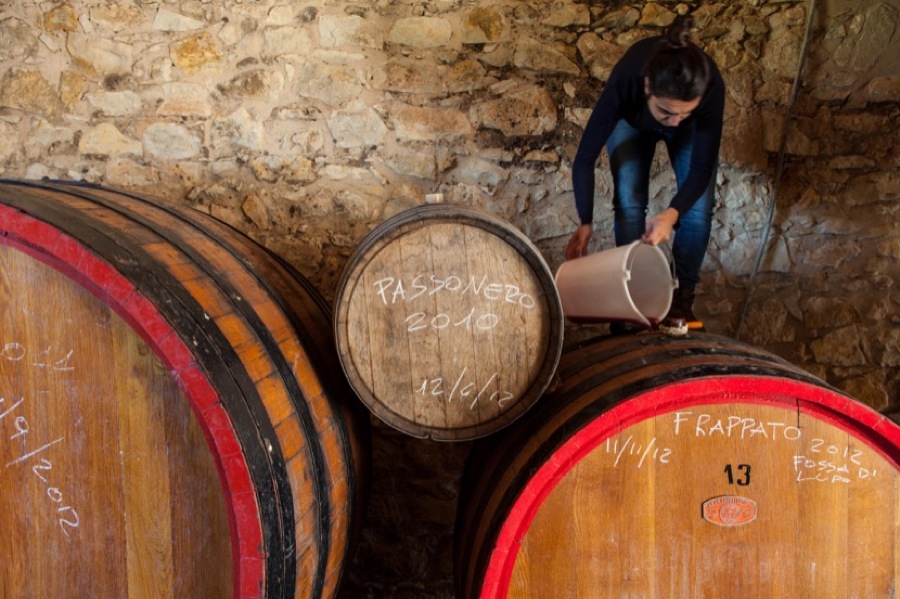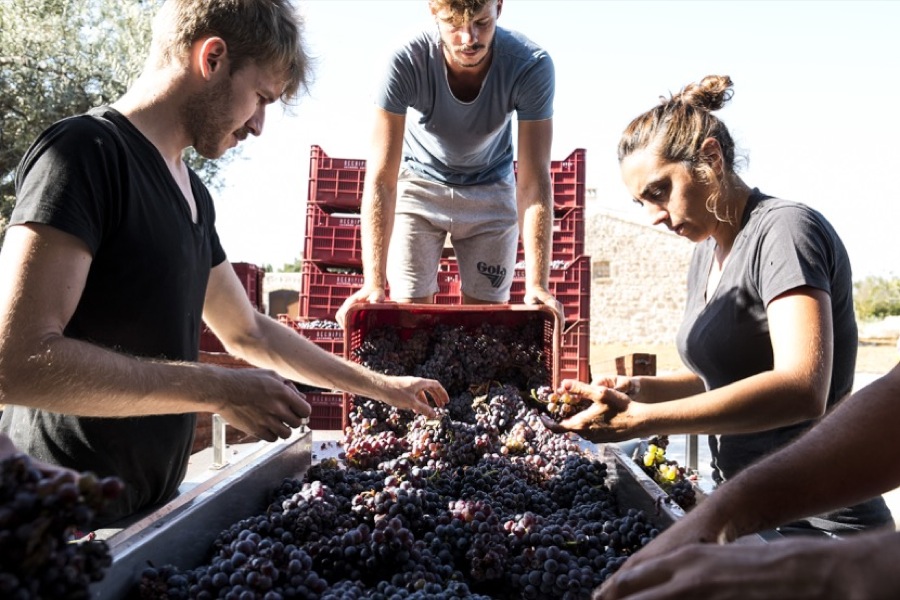
“Natural wine” shows up in many restaurants, shops, and wine discussions—or arguments—these days. It gets much more attention today than it did even three or four years ago. Despite the growing popularity and the very traditional methods many of its producers use, natural wine is new to a lot of people. And, even among those who drink it, there is confusion about what natural wine is.
So, what is natural wine?
It’s not surprising that so many people don’t know or don’t agree. There is actually no single definition of the term.
There is no legal definition of “natural wine,” nor any laws governing how it must be made. There are no certifying organizations for it, governmental or private, like there are for organic and biodynamic wines. Nobody owns the trademark for “natural wine.”
In theory, any producer could call their wine natural. Typically though, to be considered natural, the wine should be made with minimal intervention and no additives or, perhaps, just a trace of sulfur.
Since there are no rules for the winemaking, there are no rules regarding the fruit used either. Organic and biodynamic wines must be made with organically or biodynamically grown fruit, which means no synthetic fertilizes, pesticides or herbicides can be used. Natural wines may or may not be made with such fruit.
What does “minimal intervention” mean?
As with natural wine, there are no strict rules regarding minimal intervention. The term is hijacked by marketers more often than is “natural wine,” because it tends to connote a positive attribute with no downside but also has no clearly defined criteria. Even people who don’t know anything about how wine is made are attracted to the idea of wines that aren’t manipulated or manufactured. The term is used by a many producers with different regimens.
Minimal intervention doesn’t mean zero intervention. Grapes don’t fall from the bunches only to land in bottles as wine. Wine is made.
Unlike all other fruits though, grapes have naturally occurring yeasts on their skins. When the skin of a grape breaks and juice seeps out, fermentation can start. So, the typical goal of minimal intervention producers is to guide and protect that process at commercial volumes.
The producer picks grapes, rather than collecting them from off the ground. The grapes are brought into a winery and sorted, to protect the grapes and ensuing wine from outside forces, to select the best of the fruit, and to reduce the risk of contamination. Usually, but not always, winemakers crush or press the fruit to release more juice for fermentation. After fermentation, wineries may age the wine before bottling, so it’s ready for drinking upon release.
But there are still many choices producers make and many opportunities to intervene “minimally.” De-stemming is not strictly necessary and has an effect on the fermentation process, flavor profiles, and texture. The choice of fermentation vessel—new oak, used oak, large or small barrels, stainless steel, or concrete—makes a big difference in the final result. For red wines, the cap of grape solids needs to be kept moist by punching down or pumping over. After fermentation, is only free-run juice used or are the grapes pressed and, if so, how?

Use of Sulfur
Another key point in the making of minimal intervention wine, and even natural wine, is whether or not to add sulfur at any point. Purists say none should be added. But that introduces substantial risk.
Application of sulfur to fruit before fermentation will kill most naturally present yeasts. Since most natural and or minimalist winemakers want to use “native yeast,” they won’t apply sulfur before fermentation.
However, use of sulfur after fermentation protects against oxidation, can eliminate potentially harmful bacteria, and prevents fermentation from restarting in a wine which has a little residual sugar but isn’t fined or filtered. When used sparingly and at the right time, the sulfur will be undetectable to all but the most sensitive wine drinkers. And, despite the common misconception, sulfur in wine does not give people headaches.
Many people, including some wine experts, who complain about the character of specific natural wines or the category in general, do so because of the effects various bacteria can have on wines made with little or no sulfur. Frequently, but by no means always, bacteria will act on such wines and create one or more distinctive changes in the wine after fermentation. These can include volatile acidity (the smell, taste and acidity of vinegar), brettanomyces (the smell and taste of leather, sweat, iodine, or barnyard), or the flavors and sensations of continuing fermentation.
People who enjoy drinking kombucha may like these elements. They may also argue this is a natural condition of wine and should be appreciated. To others, these phenomena can overwhelm the purer attributes of wine and make it harder, not easier, to get a sense of terroir.
It is absolutely possible to make clean wine—wine that is not excessively affected by bacteria—without using sulfur. However, doing so requires ideal conditions, including a vineyard with little disease pressure, a very sanitary winery with appropriate temperature and humidity, and just the right level of sugar in the grapes for the fermentation yeasts involved. It also requires vigilance on the part of the winemaker, ensuring that fermentation and storage temperatures are correct, among other things. That isn’t always possible. And, even with the best winemakers and conditions, things can go wrong.
Are natural wine and orange wine the same thing?
Orange wine refers to wine made with juice from white wine grapes that has been allowed to soak with, or is fermented with, the skins and grape solids. That is the way red wines are made. White wines are made without skin contact.
Inclusion of the grape skins imparts color (pink, orange or amber), an additional range of flavors, and tannins. The wines look, smell, taste, and feel different than “normal” white wines.
Some natural winemakers use this method because they believe pressing grapes and only fermenting the juice is too much intervention. Plenty of natural winemakers don’t agree and choose not to make orange wine. And some producers of orange wine use ample sulfur, add commercial yeast, or do other things natural winemakers would reject. So, natural wine and orange wine are not the same thing. though some orange wines are “natural.”
Conclusion
Natural wine is increasingly popular. But neither natural wine nor minimal intervention wine are well-defined. And, of course, they can be made from any grape variety and in any region. As with other styles of wine, a person can only know if they like a particular wine by trying it.
However, there are questions you can ask that may help you determine if an individual wine is for you. Start with the basics: grape, region, body, fruity vs. savory, and oak usage. After that, inquiring about sulfur may give you a further clue as to the character of the wine.
JJ Buckley doesn't categorize wines by categories such as natural or minimal intervention, but definitely carries wines which could be considered to be made in those ways. Jean-Louis Chave considers their methods to be minimal intervention. Their Offerus is a powerful, St. Joseph Syrah. The Occhipinti SP68 is complex, savory blend of Nero d'Avola and Frappato from southeastern Sicily. The wines of Comtes Lafon in Burgundy are made from organically and biodynamically grown fruit with native yeasts. These are just a few examples.
JJ Buckley guest blogger Fred Swan is a San Francisco-based wine writer, educator, and authority on California wines and wineries. His writing appears in The Tasting Panel, SOMM Journal, GuildSomm.com, Daily.SevenFifty.com, PlanetGrape.com, and his own site, FredSwan.Wine (formerly NorCalWine). He teaches at the San Francisco Wine School. Fred’s certifications include WSET Diploma, Certified Sommelier, California Wine Appellation Specialist, Certified Specialist of Wine, French Wine Scholar, Italian Wine Professional, Napa Valley Wine Educator and Level 3 WSET Educator. He's twice been awarded a fellowship by the Symposium for Professional Wine Writers.
Copyright JJ Buckley 2018. Photos courtesy of Arianna Occhipinti